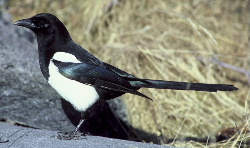Black-billed Magpie
From Wikipedia, the free encyclopedia
Order: Passeriformes
Family: Corvidae
[Photo] Black-billed Magpie (Pica hudsonia). public domain USFWA
The Black-billed Magpie is a large bird in the crow family that can be seen in the western half of North America from Alaska to Oklahoma.
Externally, it is almost identical with European Magpie, Pica pica, and is considered conspecific by many sources. The American Ornithologists' Union, however, splits it as a separate species, Pica hudsonia, on the grounds that mtDNA sequence studies place it closer to California's Yellow-billed Magpie, Pica nuttalli, than to the European Magpie. If this view is correct, the Korean subspecies of the European Magpie, Pica pica sericea, should also be considered a separate species (Lee et al., 2003).
Evolution
It appears that after the ancestral magpie spread over Eurasia, the Korean population became isolated and only after that was North America colonized via Beringia, where the two American magpies then differentiated. Fossil evidence (Miller & Bowman, 1956) indicates that the ancestral North American magpie had arrived in its current range around the mid-Pliocene (c. 3-4 mya) and that the Yellow-billed Magpie lineage split off rather soon thereafter due to the Sierra Nevada uplift and the beginning ice ages. The comparatively low genetic difference, however, suggests that some gene flow between the Black-billed and Yellow-billed magpies still occurred during interglacial periods until the Pleistocene.
Typical size and appearance
The Black-billed Magpie is 43-50 cm long, with the male larger than the female. It has a black head, breast, lower belly and upperparts, white shoulders and primary wing feathers, dark blue inner wings, and a long graduated green and blue tail which makes up half this bird's total length. The feathers of the tail and wings are iridescent, reflecting a bronzy-green to purple.
Reproduction
Adult magpie pairs stay together year-round and for life unless one dies, in which case the remaining magpie finds another mate.
The breeding season for magpies is from late March to early July.
The female incubates six or nine eggs for 16 to 18 days. The male feeds the female throughout incubation.
Young fly three to four weeks after hatching, feed with adults for about two months, and then fly off to join other juvenile magpies.
The life span of a magpie in the wild is four to six years.
Nesting
Black-billed magpies nest once a year, but will re-nest if their first attempt fails.
Magpies nest individually or in loose colonies, frequently toward the top of deciduous or evergreen trees or tall shrubs.
Nests are built by both sexes over a 40- to 50-day period. Old nests are repaired and used, or a new nest is built on top, with older nests reaching 48 inches deep by 40 inches wide.
Nests are loose accumulations of branches, twigs, mud, grass, rootlets, bark strips, vines, needles, and other materials, with branches and twigs constituting the base and framework. The nest cup is lined with fine rootlets, grass, and other soft material.
Nests almost always contain a hood or dome of loosely assembled twigs and branches, and usually have one or more side entrances.
Other bird species, including small hawks and owls, often use old magpie nests.
Food and foraging habits
The Black-billed Magpie is omnivorous, eating many types of insects, carrion, eggs and rodents, as well as berries, seeds and nuts, and also garbage and food from pets that are fed outside. It forages on the ground, but also may steal food from other birds.
Migration
It is mainly a permanent resident; some birds may move south or to lower elevations in winter, while others may wander east after the breeding season.
Songs and calls
The call of this bird is a nasal inquisitive chug chug chug, "mag? mag? mag?" or "yak yak yak". Its calls are much higher pitched than the European Magpie's.
Other
During the first half of the 20th century, black-billed magpies were considered detrimental to game-bird populations and domestic stock, and were systematically trapped or shot. Many also died from eating poison set out for coyotes and other predators. In 1933, 1,033 magpies were shot in Washington’s Okanogan valley by two teams of bounty hunters.
http://en.wikipedia.org/wiki/Black-billed_Magpie
| The text in this page is based on the copyrighted Wikipedia article shown in above URL. It is used under the GNU Free Documentation License. You may redistribute it, verbatim or modified, providing that you comply with the terms of the GFDL. |
|

